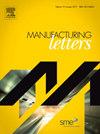Improving surface integrity of GH4169 alloy through magnetic-assisted cutting
IF 1.9
Q3 ENGINEERING, MANUFACTURING
引用次数: 0
Abstract
GH4169 alloy presents superior properties such as high strength and resistance to high temperature, but possesses poor machinability. To ameliorate the problem and improve the machined surface integrity of GH4169 alloy, this paper focused on the application of magnetic-assisted cutting (MAC) for GH4169 alloy. In the MAC process, a permanent magnetic field (the magnetic field intensity is 0.25 T) was applied to the workpiece material during cutting, and its impact on chip morphology, tool damage and surface integrity was investigated. By comparing to traditional cutting (TC), the introduction of a magnetic field results in a reduction in the chip thickness and minimizes chip serration, leading to smoother cutting process and reduced fluctuations in cutting forces. Meanwhile, the introduction of magnetic field resulted in a substantial decrease in the notch wear and abrasion of cutting tool, and mitigated the excessive growth of built-up edge (BUE), which improved the tool life and machined surface integrity. By analyzing the machined surface at the end of TC and MAC, it was found that the surface roughness at the end of MAC was reduced by 22.4 %. Meanwhile, the cavity, side flow and debris of BUE, which tend to occur in the machined surface during the TC process, are effectively suppressed after MAC. Furthermore, Microstructural analysis of the machined surface indicated an enhancement in the dislocation density on the machined surface layer, suggesting the magnetoplastic effect of the magnetic field on GH4169 alloy.
通过磁力辅助切割提高 GH4169 合金的表面完整性
GH4169 合金具有高强度和耐高温等优越性能,但机加工性能较差。为了改善这一问题,提高 GH4169 合金的加工表面完整性,本文重点研究了磁辅助切削(MAC)在 GH4169 合金中的应用。在磁辅助切削过程中,切削时对工件材料施加永磁磁场(磁场强度为 0.25 T),并研究其对切屑形态、刀具损伤和表面完整性的影响。与传统切削(TC)相比,磁场的引入可减小切屑厚度,减少切屑锯齿,从而使切削过程更顺畅,切削力波动更小。同时,磁场的引入大大降低了切削工具的缺口磨损和磨耗,缓解了积聚刃(BUE)的过度增长,从而提高了工具寿命和加工表面的完整性。通过分析 TC 和 MAC 末端的加工表面,发现 MAC 末端的表面粗糙度降低了 22.4%。同时,TC 加工过程中容易出现在加工表面的空腔、侧流和 BUE 碎片在 MAC 加工后得到了有效抑制。此外,对加工表面的微观结构分析表明,加工表面层的位错密度有所增加,这表明磁场对 GH4169 合金产生了磁塑效应。
本文章由计算机程序翻译,如有差异,请以英文原文为准。
求助全文
约1分钟内获得全文
求助全文
来源期刊

Manufacturing Letters
Engineering-Industrial and Manufacturing Engineering
CiteScore
4.20
自引率
5.10%
发文量
192
审稿时长
60 days
 求助内容:
求助内容: 应助结果提醒方式:
应助结果提醒方式:


